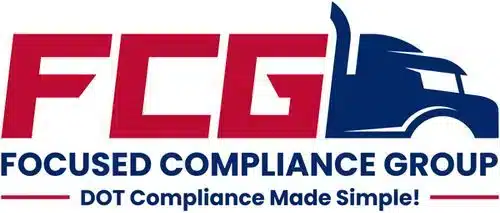A Complete Guide to FMCSA Safety Score: What It Is, Why It Matters, and How to Improve It
If you run a trucking business, your FMCSA Safety Score is one of the most critical factors affecting your operations. These scores, along with a company’s safety rating, impact insurance rates, business opportunities, DOT audits, and even your ability to stay on the road legally.
At Focused Compliance Group, we help trucking companies maintain compliance, improve safety scores, and avoid costly penalties. In this guide, we’ll break down:
• What FMCSA Safety Scores are.
• How they affect your business.
• The common mistakes that hurt your score.
• Proven ways to improve low scores.
Let’s dive in.

Understanding the CSA Program
The Compliance, Safety, Accountability (CSA) program is a federal initiative aimed at improving safety on America’s roadways. Launched in 2010, the program uses a complex algorithm to evaluate the safety performance of motor carriers and drivers. The CSA program assesses safety data from various sources, including roadside inspections, crash reports, and compliance reviews. This information is then used to assign a safety rating to each motor carrier, which can impact their ability to operate and their reputation in the industry.
What Are FMCSA Safety Scores?
The Federal Motor Carrier Safety Administration (FMCSA) assigns safety scores to trucking companies based on their compliance with federal regulations. These scores are designed to identify high-risk carriers and ensure road safety.
A full compliance review is a critical assessment process that motor carriers undergo to obtain a safety rating. Your safety score is determined through the Compliance, Safety, and Accountability (CSA) program, which monitors company safety performance in seven key categories, known as the Behavior Analysis and Safety Improvement Categories (BASICs).
How FMCSA Safety Scores Work
FMCSA assigns Safety Measurement System (SMS) scores based on violations, inspections, and crash data. Scores are calculated within BASIC categories, with higher scores indicating worse performance.
A conditional safety rating indicates the presence of safety management deficiencies and can adversely affect business operations.
The Seven Basics Categories
Each category is scored on a percentile scale (0-100%), with higher numbers indicating a worse safety record. FMCSA monitors performance in the following areas:
1️⃣ Unsafe Driving – Violations for speeding, reckless driving, texting while driving, improper lane changes, and other dangerous behaviors.
2️⃣ Hours-of-Service (HOS) Compliance – Issues related to violations of federal driving time limits, missing logs, and falsified records.
3️⃣ Driver Fitness – Problems with CDL requirements, medical certifications, or driving records.
4️⃣ Controlled Substances & Alcohol – Failed drug/alcohol tests, possession of drugs/alcohol in a CMV, or impaired driving violations.
5️⃣ Vehicle Maintenance – Violations for faulty brakes, lights, tires, or any other mechanical defects. Maintaining comprehensive maintenance records is crucial for compliance with federal regulations and for demonstrating that a vehicle is properly maintained.
6️⃣ Hazardous Materials (HM) Compliance – Issues related to hazmat labeling, packaging, and documentation.
7️⃣ Crash Indicator – Preventable crashes and frequency of accidents involving the carrier.
How Are Safety Scores Calculated?

FMCSA assigns points for each violation, with more severe violations carrying heavier penalties. The agency considers violation severity, frequency, and recency, meaning that recent violations weigh more heavily than older ones.
If your BASIC scores exceed FMCSA thresholds, your company may be subjected to audits, investigations, and penalties.
What is a DOT Safety Rating?
A DOT safety rating is a publicly accessible record of a motor carrier’s safety performance. The rating is assigned by the Federal Motor Carrier Safety Administration (FMCSA) and is based on the results of a compliance review. There are three possible safety ratings: Satisfactory, Conditional, and Unsatisfactory. A Satisfactory rating indicates that a motor carrier has effective safety management controls in place, while a Conditional rating suggests that improvements are needed. An Unsatisfactory rating can result in a motor carrier’s operating authority being revoked.
Why Your FMCSA Safety Score Matters for Motor Carriers
A bad FMCSA safety score can have serious consequences for your trucking company, including:
🚨 DOT Audits & Investigations – Poor scores increase the likelihood of a DOT compliance review or on-site investigation.
💰 Higher Insurance Premiums – Insurers use FMCSA data to set rates—higher scores mean more expensive insurance.
🚛 Loss of Business Opportunities – Many brokers and shippers won’t work with carriers that have poor scores.
⛔ Out-of-Service Orders – Severe violations can result in your company being shut down.
📉 Damaged Reputation – A bad safety record can scare away customers and partners.
Fleet safety impacts safety ratings and regulatory compliance, and is crucial for the proper operation of motor vehicles.
A strong safety score keeps your business running smoothly, helps you secure contracts, and lowers your operational costs.
The Importance of Safety Management Controls
Safety management controls are the systems and processes that motor carriers use to ensure compliance with safety regulations. These controls include policies, procedures, and training programs that promote safe driving practices, vehicle maintenance, and driver fitness. Effective safety management controls are essential for maintaining a good safety rating and avoiding costly fines and penalties. Motor carriers that prioritize safety management controls can reduce their risk of accidents, improve their reputation, and increase their competitiveness in the industry.
What Hurts Your FMCSA Safety Score?
Many trucking companies struggle with their safety scores due to avoidable mistakes. Here are the most common issues that hurt scores:
❌ Reckless Driving Violations – Speeding, texting, tailgating, and improper lane changes increase unsafe driving scores.
❌ Hours of Service (HOS) Violations – Logbook errors, exceeding driving limits, or failing to use ELDs properly.
❌ Maintenance Issues – Failing roadside inspections due to bad brakes, tires, or lights. Failing vehicle inspections can significantly hurt your safety score.
❌ Failed Drug & Alcohol Tests – Any drug/alcohol violation significantly increases your risk score.
❌ Unqualified Drivers – Allowing unlicensed or medically unfit drivers to operate a CMV.
❌ Too Many Preventable Accidents – Frequent at-fault crashes hurt your Crash Indicator score.
❌ Hazmat Compliance Errors – Incorrect paperwork, labels, or placards for hazardous materials.
The good news is that your scores can be improved with the right strategies.
How to Improve a Low FMCSA Safety Score After a Compliance Review
If your FMCSA safety scores are high, you need to act fast to avoid serious penalties. Here are some proven strategies to lower your scores and stay compliant:

✅ 1. Improve Driver Training
• Conduct mandatory safety training for all drivers.
• Emphasize defensive driving, HOS compliance, and drug/alcohol policies.
• Require regular refresher courses to reinforce safe driving habits.
✅ 2. Strengthen Vehicle Maintenance
• Implement a strict preventive maintenance program.
• Perform daily pre-trip and post-trip inspections.
• Address vehicle defects immediately to avoid violations.
• Fleet managers can use digital tools to get instant updates on vehicle faults, allowing for timely repairs and efficient recordkeeping.
✅ 3. Monitor Hours-of-Service (HOS) Compliance
• Use Electronic Logging Devices (ELDs) properly.
• Train drivers on HOS rules and logbook accuracy.
• Conduct regular audits to ensure compliance.
✅ 4. Enforce Drug & Alcohol Testing
• Enroll in a DOT-compliant drug & alcohol testing program (Focused Compliance Group can help!).
• Ensure all drivers undergo pre-employment, random, and post-accident testing.
• Immediately remove drivers who fail drug or alcohol tests from safety-sensitive duties.
✅ 5. Address Driver Violations Promptly
• Monitor CSA scores weekly and identify problem drivers.
• Provide corrective training for drivers with violations.
• Reward drivers with clean records to encourage safe driving.
✅ 6. File a DataQ Challenge for Incorrect Violations
• If a violation or accident is recorded incorrectly, file a DataQ Challenge to have it removed.
• Gather evidence (dashcam footage, inspection reports, etc.) to support your claim.
✅ 7. Partner with Compliance Experts
Staying compliant can be overwhelming, but Focused Compliance Group is here to help. We offer:
✔ Safety & Compliance Audits
✔ DOT Drug & Alcohol Testing Programs
✔ CSA Score Monitoring & Improvement Plans
✔ Driver Training & HOS Compliance Assistance
Take Control of Your FMCSA Safety Score Today!
A bad FMCSA safety score can put your business at risk, but with the right strategies, you can improve compliance, lower your scores, and protect your company.
Let Focused Compliance Group help you stay on track!

Don’t wait until you’re facing fines, audits, or a shutdown—get proactive and improve your FMCSA safety score now!
How to Find and Dispute Your Safety Rating
Motor carriers can find their safety rating on the FMCSA’s Safety and Fitness Electronic Records (SAFER) website. To access their rating, motor carriers will need to enter their USDOT number and PIN. If a motor carrier disagrees with their safety rating, they can dispute it by submitting a request for a rating change. The FMCSA will review the request and may request additional information or documentation to support the motor carrier’s claim.
The Impact of Safety Ratings on Your Business
A motor carrier’s safety rating can have a significant impact on their business. A good safety rating can improve a motor carrier’s reputation, increase their competitiveness, and reduce their risk of accidents. On the other hand, a poor safety rating can result in costly fines and penalties, increased insurance rates, and a loss of business. Motor carriers that prioritize safety management controls and maintain a good safety rating can improve their bottom line and stay ahead of the competition.
